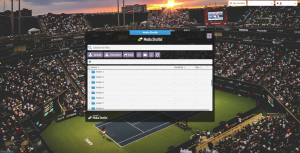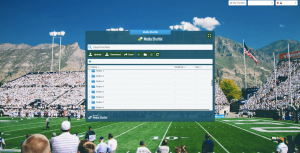SVG Tech Insight: Resilience and Innovation Define the Return of Live Sports
This fall SVG will be presenting a series of White Papers covering the latest advancements and trends in sports-production technology. The full series of SVG’s Tech Insight White Papers can be found in the SVG Fall SportsTech Journal HERE.
For many, the cancellation of live sports was the first sign that COVID-19 was going to be more disruptive than everyone had hoped. Though an onslaught of similar cancellations followed in the ensuing weeks, the early March suspension of play for the NBA felt like something of a shot across the bow for sports leagues in the U.S. and beyond, with the shock peaking with the March 24 postponement of the summer games.
As the months have gone on, many prominent leagues are now returning to some level of normalcy, though what that will ultimately look like varies depending on the parameters of a given sport. Broadcasters, too, are asking themselves how they can produce live sports safely, navigating the minefield of COVID-19 and the demands of an anxious and starved audience.
While each league is putting their own plan together, one theme remains common. There will be a lot less people present, and that includes production crews.
The state of the (live sports) union
After weeks of questions, the M&E industry began to get answers as to what the return of live sports would look like in early May. International leagues paved the way, with Taiwanese baseball firing up in April, the return of South Korea’s KBO League, (quickly followed by a deal with ESPN allowing the network to broadcast six games a week), and Germany’s Bundesliga football association springing into action with seven games beginning on May 16. In each of these cases, the return strategies typified what the world has seen and heard from other organizations, including many conditions long-anticipated, such as the prohibition of spectators during games.
Although months have passed since then (and the conversation is now more heavily focused on larger U.S.-based leagues such as MLB and the NBA, both of which resumed their seasons in late July), many of the defining features of those early days remain front and center, both for organization (when the NHL resumed in August, they restricted all their matches to Toronto and Edmonton, much as NASCAR limited races to two locations when it picked back up on May 17), and broadcasting. The strategies that production teams and leagues developed at the beginning of the summer, thus, continue to provide unique opportunities and unique challenges.
Remote production paves the way
While remote production has been a growing force in media, it wasn’t until this outbreak that “reality” became “necessity,” and “necessity” slowly began to look like “advantage.” For live sports, broadcasters devised strategies to shrink the number of production personnel onsite, transferred larger amounts of content to offsite teams, added more pre-recorded content and advanced graphics along with a dispersed team of remote editors. Signiant has a unique lens into this, as its software products are widely used across live sports production and the platform has seen a massive surge in usage in recent months as these remote workflows have been put in play.
Implementing highly advanced sterilization tools, leveraging video conferencing, and coordinating staff to limit density and maximize efficiency, major broadcasters like Fox Sports, BT Sports, and NBCUniversal have made major strides. Faced with complications, sports and production organizations alike have gotten creative. For instance, the totally remote NFL and MLB Drafts invested in a hefty amount of pre-recorded content — including PSAs and musical acts — which kept the broadcast flowing and captivated fans despite the unorthodox circumstances.
And it’s not just about making do. Many broadcasters found the current conditions actually allow for exciting experimentation and elucidate previously untapped opportunities. Without crowds in the bleachers, Fox Sports, for instance, discovered new camera angles that previously wouldn’t have been possible, along with using high-speed, custom drone cameras to help reinvigorate NASCAR fans.
For all these innovations, leagues and broadcasters are also aware of the challenges that will no doubt arise, especially around bandwidth. During SVG’s own Sports Content Management Virtual Series, Grant Nodine, SVP of technology with the NHL, discussed the difficulties around moving content efficiently when play is restricted to limited locations. As he explains it, with three games in a day, production teams will have to be quick on their feet, moving footage of one game quickly into archives, then immediately preparing to send pre-recorded footage and relevant graphics for the following match back to the trucks. In these conditions, ordering workflows, leveraging intelligent transfer software that optimize throughput, and staying on top of what content will be needed when will prove vital.
Innovating the fan experience
As effective as broadcasters have been at addressing many of the production challenges posed by a totally remote model, there are still some questions that have yet to be answered, one of which is how the lack of fans affects viewing experience.
Although there was an established consensus among both fans and leagues that, when live sports came back, the bleachers would have to remain empty for some time, it’s likely that many underestimated the impact this could have on the viewing experience. When the aforementioned Bundesliga football association resumed play, one of the main complaints from otherwise enthusiastic viewers was that there was something strange about seeing a sport — so long defined by its passionate, no-holds-barred fanbase — played on a pitch with completely empty stands.
Recently, broadcasters have turned to a number of creative avenues to try to rectify this. Some games gave fans the option to purchase a cardboard cutout of themselves that would be placed in the bleachers (with one unfortunate man almost getting his fake head taken off by a home run ball).
A more interesting approach, however, can be seen on Fox Sports’ broadcasts where stadiums are populated by Sim-like “virtual fans,” that can alternate basic movements to better simulate a crowd. This isn’t the first time this solution has been discussed, either. Back at the beginning of the summer, OZ Sports, an Icelandic sports technology firm, came forward with an AR solution known as OZ Arena, which could add digital fans to a stadium, complete with crowd-sourced audio. OZ Arena could be deployed at a broadcasting facility, an OB truck, or at the stadium directly giving viewers the sense that those bleachers were as packed as ever, bringing back the rush of the live sports experience.
Live sports production is keeping its head in the game
The chaos of the last few months have put a major strain on live sports leagues and the broadcasters they work with, but — as we see the return of play — it’s clear that none of these organizations are planning on just laying down. With each new challenge the pandemic has posed, production teams have pushed themselves to innovate, discovering new ways to bring content to fans while staying safe.
Remote production has become the name of the game for live sports — now more than ever — and the benefits that the strategy is revealing will likely extend long after this period comes to a close. Leveraging intelligent file transfer solutions alongside a host of new and exciting technologies, these enterprises are getting back in the game with a confidence that’s as impressive as it is exciting. While it’s extremely likely that the landscape will keep shifting, it’s equally apparent that as it does, these businesses will keep innovating, constantly looking for the next new idea, the next play, the next way to bring it all home.


